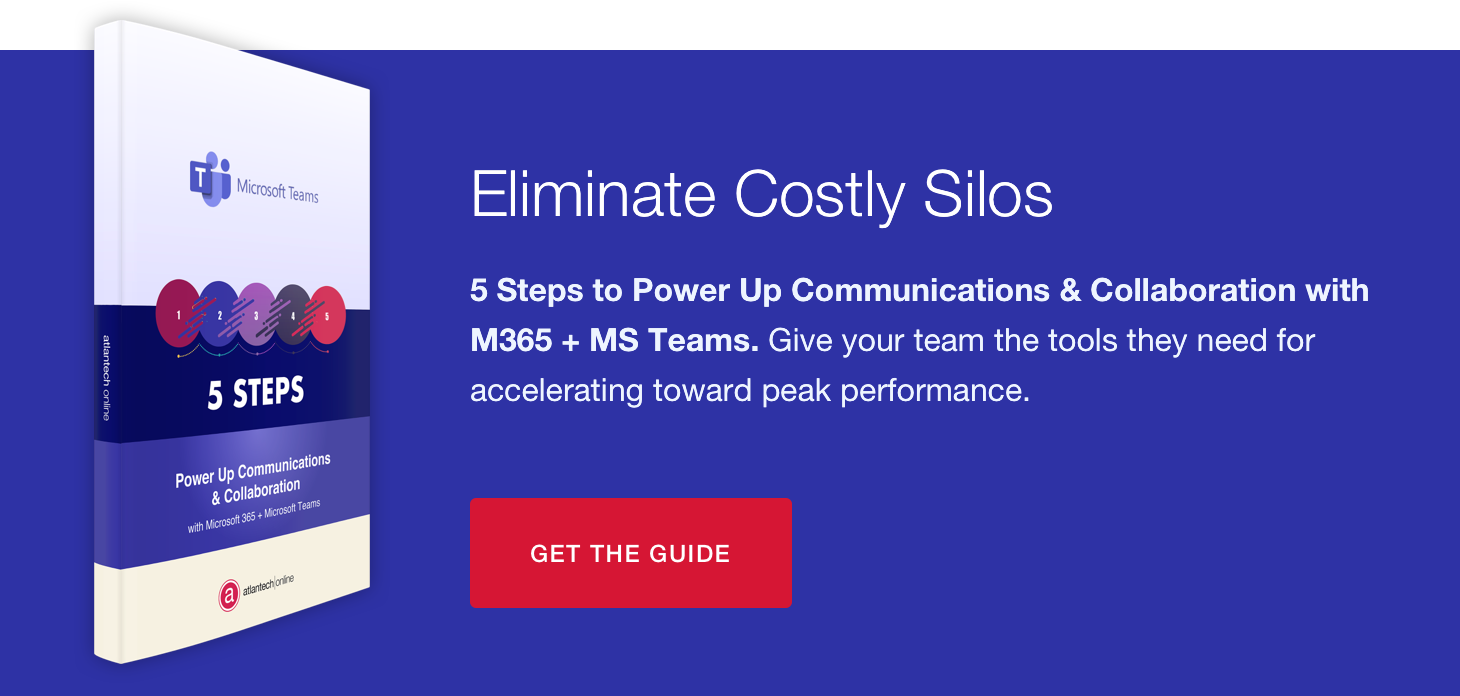Are the days of your projects being over budget and past deadlines over? Here at Atlantech Online, we use Microsoft Teams and we think so.
The average employee saves 498 hours per year by using project management software. So why are 46% of team leaders reporting that meeting project deadlines are their biggest roadblock?
Without the right project management tools and communication systems in place, projects often end up delayed and over budget. Your project management system needs to be paired with the right communication systems to deliver ROI, facilitate seamless communication, and enable your team to solve project needs.
Figuring out which communication software is right for your business helps prevent these common project management problems. In the article, we’ll lay out the pros and cons of using Microsoft Teams for your projects. In addition, this article will give you a full picture of Microsoft Teams and how it seamlessly works with project management software.
How Using Microsoft Teams for Project Management Impacts Your Business
Effective communication software improves your team’s ability to complete the five basic project management principles on time and within budget. Any software you’re considering for project management communication must enable these five principles:
- Building a project foundation, initial project conception
- Project planning and ideation
- Project launch and stakeholders check-ins
- Progress monitoring
- Presentation, knowledge sharing, and best practices updates
We know that Microsoft Teams successfully enables teams to communicate effectively and fulfill those five requirements. The biggest question remains, “Is Microsoft Teams the right solution for my business?”
Let’s review the pros and cons of using Microsoft Teams for project management communication so you can decide.

Pros of Using Microsoft Teams for Project Management
An underlying theme of the benefits of using Microsoft Teams centers around its stellar communication features. As you know, without efficient communication, successful project management is impossible. Let’s review the specifics of how Microsoft Teams can be used for project management.
Streamlined Team Communication
The features of Microsoft Teams classifies it as a unified communications as a service (UCaaS) platform. Implementing a UCaaS platform into your daily project management routine centralizes all of your team’s communication.
The communication features of Microsoft Teams include PBX calling, business calling, softphone capabilities, instant messaging communication from any device, video calling, and live status updates for your team. You can even get status updates on people who use Teams but are in other organizations. For example, if you’re looking for an instant response on a project status, you can see who is online and contact them immediately. Having these features available makes a significant difference when it comes to establishing an open line of communication.
Task Review
Microsoft Teams is a communication platform that can be used with many different types of project management software, including Microsoft Project and third-party applications. The integration of Microsoft Teams with your preferred project management platform helps you assign tasks and easily communicate with your team members. We here at Atlantech Online use Wrike.
As long as your team can keep up with task deadlines, management can get reports when they need them, and team members can easily ask for help when they hit a roadblock, your project will run smoothly. That’s one of the many reasons why UCaaS software like Microsoft Teams is vital to project management overall.
Centralized Integrations
Lack of organization is the death knell to any type of project management. When a team is disorganized, things get lost, deadlines are missed, and communication suffers. Another benefit of using Microsoft Teams for project management communication is that all of your information is centralized. When your data, documents, and communications are centralized, your team can run more efficiently.
If you’re using all Microsoft products, your communications seamlessly connect with the rest of your software, including Microsoft 365, Microsoft Project, OneDrive, Calendar, and the rest of the Microsoft apps. For non-Microsoft users, Microsoft Teams also works with many other project management tools, such as the aforementioned Wrike, Monday, Asana, and Trello.
Real-Time Collaborative Work
Forget what you know about cloud-based documents and spreadsheets. Microsoft Teams seamlessly integrates with OneDrive so you can securely share files with instant updates. The best part about utilizing Microsoft Teams with OneDrive is that when you need a progress update, your team members can easily send you the links to whatever they are working on, and you can see their live progress.
Cost Savings
There are direct and indirect cost savings associated with the Microsoft Teams platform. The direct cost savings is the low monthly cost of the platform. There is a free version of the software, Business Basic ($5/user/month), and a Business Standard version ($12.50/user/month).
The indirect cost benefits include the hours saved overall in your project management process. A Microsoft survey of the platform’s users reported that 88% of the survey respondents felt having all of their solutions in one place saves them time, and on average, users saved 1-8 hours per week.
Cons of Using Microsoft Teams for Project Management
Similar to any software, Microsoft Teams has some disadvantages, especially when first adopting the software.
Learning Curves
One of the disadvantages reported by users of Microsoft Teams is the initial learning curve. Switching over from another UCaaS platform is usually a minor adjustment for many companies, but for companies who have never used a UCaaS platform, there may be a learning curve during the first couple of weeks of using the software. The learning curve of adopting Microsoft Teams depends on your team’s technological skills and adaptability.
Compatibility
Although the process is seamless once Microsoft Teams is set up, it does require ramp-up time and works best when you’re using other Microsoft products. You can, of course, use Microsoft Teams with other project management systems such as Asana or Monday. However, Microsoft applications are designed to work best interdependently.
Who is Microsoft Teams Best For?
Microsoft Teams may or may not be right for you. Similar to choosing any other software, it depends on your business needs, requirements, software budget, and overall goals.
The ideal user of Microsoft Teams is a team that wants to:
- Get more organized
- Communicate efficiently and effectively
- Seamlessly send and receive live document updates
- Be able to communicate with other team members on their preferred method of communication
Lastly, Microsoft Teams is for project management professionals who want easy communication that improves their projects and who are open to using a Microsoft solution.
Get Started with Microsoft Teams
Using Microsoft Teams for project management is a scalable way to connect your on-site and remote workers, enables project management productivity, and delivers cost savings and ROI.
So what's your next step? I'd recommend checking out the guide below. You'll gain insight into how the combination of Microsoft Teams and Microsoft 365 eliminate silos for product management and overall across your company.


